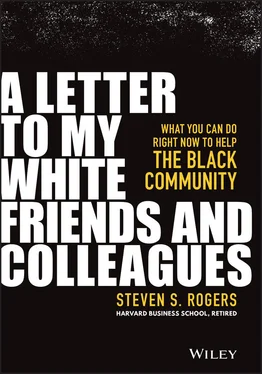We see that decisions refusing to share wealth, combined with the financial benefits of slavery going to Whites exclusively, generation after generation, is the foundation of the wealth gap between Blacks and Whites. This unbridged chasm started over 400 years ago.
Beginning as an enslaved people without the right to earn a living or accrue wealth from their work or to transfer any acquired wealth over 12 succeeding generations has left many of the country's Black Americans in a chronic perpetual state of poverty, making it almost impossible to generate financial independence or create a viable community economy to parallel that of White Americans. A perfect example of this disparity plague is the city of Boston, where a 2017 study showed the average White household had a net worth of almost $250,000 compared to a net worth of $8 for Blacks (the noted amount is not an error). 15
Even more disturbing has been the reaction from Whites whenever there have been instances of Black success that could become the basis of wealth generation. One of the most prominent examples is the 1921 story of Tulsa, Oklahoma's “Black Wall Street” when a mob of White citizens destroyed the city's Black business community in a terrorist attack that witnessed the first aerial bombardment of American citizens on U.S. soil. 16 While this story of the destruction of 600 Black businesses is well known in the Black community, a recent survey by NBC news in Chicago reported that 94% of Whites had never heard of this event.
Racial inequities create systemic cracks in the structural strength of our country. They result in health issues, social problems, reduced happiness, and diminished economic growth. Wealth inequality is one of the roots of systemic racial problems, because wealth is a resource that provides the basis for financial security (short and long term) and political power. Wealth provides individuals, families, and groups with the power of mobility and a sense of agency because it is a strength developed across lifetimes and handed down through generations. And in addition to being a systemic issue, wealth inequality is a generational problem, undermining any foundation for the stability of the Black community, and for America.
How do we make America fulfill the dream first envisioned in Thomas Jefferson's Declaration of Independence? How do we reclaim the America that was betrayed in that great compromise of 1787, when the Constitution was created and excluded Blacks from a timelier participation in this great experiment? The solutions I offer in this book focus on seeking financial equity. Black Americans were officially excluded from wealth generation for 246 years through government-sanctioned slavery and over 100 years of other anti-Black public policies. Therefore, we need to take extraordinary steps – even more radical than what was true of affirmative action – to correct the wrong. As Nikole Hannah-Jones of the New York Times said, “All of this inequality was intentionally constructed. Therefore, all of it can be intentionally deconstructed.”
So, what is the road forward? What can be done to undo the financial apartheid that has resulted in Whites having 10 times the net worth of Blacks? Just as Nelson Mandela and willing White Afrikaaners helped South Africa avoid social disruption that was broiling increasingly hotter in their country, we need similar leadership. I know that the problems include issues with the police, but my focus is on what I believe is an equally important cause of the protests, and that is the wealth disparity. Therefore, you, my White colleagues in the business community, are needed to help diffuse the pressures that drive the wealth disparities that contributed to the past riots and fuel the current protests that are breaking out with increasing frequency in 21st-century America.
To the White business community that asks, “What can I do?” please imagine that the current status of Black America is the result of a terrible wound. Therefore, the task here is to heal that wound, to salve the hurt from the blow. Even Harvard University is now asking this question about redemption as they publicly recognize the fact that enslaved Black men and women were forced to work on the campus as early as 1639. In fact, the names of four of those enslaved people were identified in a ceremony on campus in 2016. Congressman John Lewis was the keynote speaker. Four of those enslaved people were Titus, Venus, Bilhah, and Juba. They were owned by Harvard University presidents Benjamin Wadsworth and Edward Holyoke from 1725 to 1737. 17
The recommendations detailed in the following chapters examine how we may heal the wound by eliminating the Black-White wealth gap. To that end, the chapters will:
1 Provide you with practical solutions on how you can help the Black community.
2 Help you understand how you can improve Black-White racial relations.
3 Teach Black American history that you likely did not learn in high school or college.
4 Identify some root causes of the country's race problems, because root cause analysis is key to determining solutions.
5 Help you empathize with the socioeconomic challenges experienced by most of the 30 million Black Americans who are not entertainers or athletes.
6 Teach that Black Americans are the most loyal and patriotic group of people in the country.
7 Teach that eliminating the $153,000 wealth gap between Blacks and Whites is the solution to an overwhelming percentage of our problems.
Sincerely, your friend and advisor,
Steven Rogers
1 1. Jan, Tracy. “White Families Have Nearly 10 Times the Net Worth of Black Families. And the Gap Is Growing.” Washington Post, September 28, 2017. https://www.washingtonpost.com/news/wonk/wp/2017/09/28/black-and-hispanic-families-are-making-more-money-but-they-still-lag-far-behind-whites/
2 2. Darity, W. A., Darrick Hamilton, Mark Paul, Alan Aja, A. Prince, Antonio Moore, and Caterina Chiopris. “What We Get Wrong about Closing the Racial Wealth Gap.” Samuel DuBois Cook Center on Social Equity at Duke University, April 2018. https://socialequity.duke.edu/portfolio-item/what-we-get-wrong-about-closing-the-racial-wealth-gap/
3 3. Baradaran, Mehrsa. The Color of Money: Black Banks and the Racial Wealth Gap. Harvard University Press, 2017.
4 4. “Slavery and the Making of America.” PBS. n.d. www.Thirteen.org. https://www.thirteen.org/wnet/slavery/about/p_transcript2.html
5 5. Martin, Bonnie. “Slavery's Invisible Engine: Mortgaging Human Property.” Journal of Southern History 76, no. 4 (2010): 817–866.
6 6. “Let Us Put Our Money Together: The Founding of America's First Black Banks.” n.d. www.Kansascityfed.org. Accessed December 27, 2020. https://www.kansascityfed.org/publications/aboutthefed/letusputourmoneytogether
7 7. Berry, Daina Ramey. “Beyond the Slave Trade, the Cadaver Trade.” New York Times, February 3, 2018. https://www.nytimes.com/2018/02/03/opinion/sunday/cadavers-slavery-medical-schools.html
8 8. Okeowo, Alexis. “How Saidiya Hartman Retells the History of Black Life.” New Yorker, October 26, 2019. https://www.newyorker.com/magazine/2020/10/26/how-saidiya-hartman-retells-the-history-of-black-life
9 9. Keyes, Allison. “The ‘Clotilda,' the Last Known Slave Ship to Arrive in the U.S., Is Found.” Smithsonian. Smithsonian.com. May 22, 2019. https://www.smithsonianmag.com/smithsonian-institution/clotilda-last-known-slave-ship-arrive-us-found-180972177/
10 10. Raines, Ben. “Wreck Found by Reporter May Be Last American Slave Ship.” Al. January 23, 2018. https://www.al.com/news/mobile/2018/01/alcom_reporter_may_have_found.html
11 11. “Zora Neale Hurston's Lost Interview with One of America's Last Living Slaves.” Vulture. Apri 29, 2018. https://www.vulture.com/2018/04/zora-neale-hurston-barracoon-excerpt.html
Читать дальше











